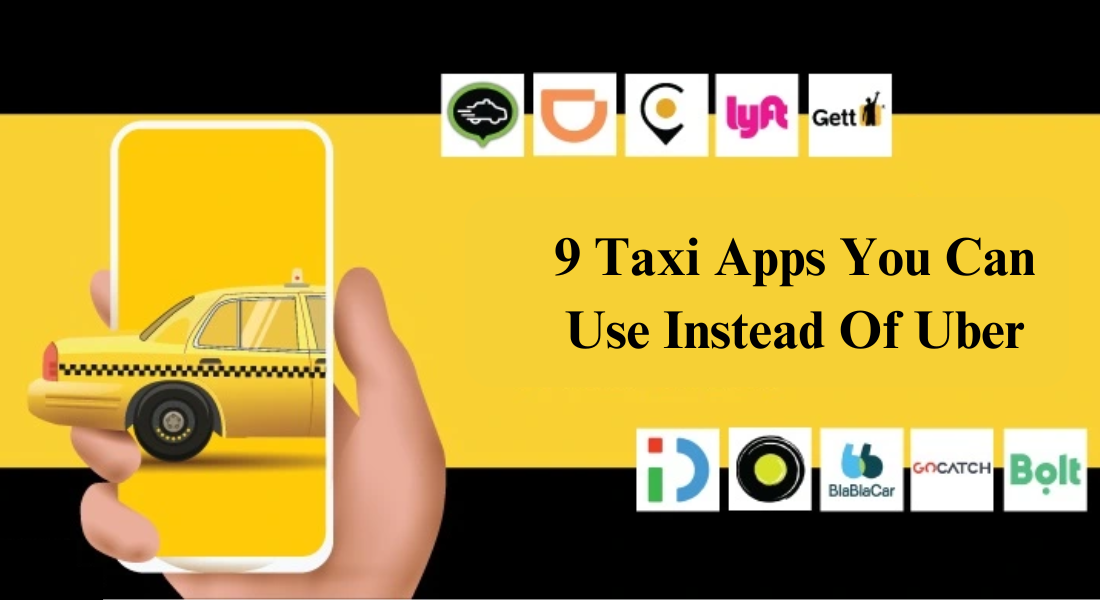Are you ready to break into the lucrative world of taxi apps?
Cab booking app development is an integral element of our daily lives. When we need to stop at a cafe, catch our flight, or simply run errands, these apps help us solve the issue of daily commuting and offer a secure and quick method of travel.
Taxi app markets are an expanding industry. The market size will likely increase to $43.15 billion by 2024 and $64.74 billion by 2028. Therefore, investing in this industry is a wise and lucrative opportunity that you shouldn’t ignore.
However, learning from the best to invest in a market like this is essential. In this way, we’ve compiled the top taxi booking applications, their functions, and their market size.
Learning about them will enable you to understand the most beneficial features of these apps that have allowed them to succeed in the highly competitive market.
Uber Alternatives- 9 Taxi Apps
If you plan to build an app similar to Uber, I suggest you look at and get motivated by the Uber Business Model of similar apps.
We’ll discuss some of the top Uber alternatives that have taken over the market exceptionally well.
Grab
Grab is a Singaporean multinational technology company founded by Anthony Tan and Tan Hooi Ling in 2012 under the name of the MyTeksi application based in Kuala Lumpur, Malaysia. The following year, it grew to become GrabTaxi. In addition, it began to expand into other services using the model of super-apps. 2014 saw GrabTaxi change its location to Singapore and rebrand itself as “Grab.”
Grab is a super-app for mobile devices that offers transportation, food delivery, and digital payment services. It is currently in operation in Malaysia, Singapore, Indonesia, Cambodia, Myanmar, Thailand, the Philippines, and Vietnam. Grab was Southeast Asia’s first decacorn and also the largest technology company in the region.
Lyft
Lyft is a company based in San Francisco, California, that offers mobility as a service, including ride-hailing, vehicle-to-hire motorized scooters, bicycle-sharing service, rental vehicles, and food delivery throughout all of the United States and select cities in Canada. Users can obtain estimates on the cost of booking a taxi. However, rates can differ based on an evolving pricing model depending on the local demand and supply during booking. In 2022, with a market share of 28, Lyft is the second-largest ridesharing firm across the United States after Uber. Due to its presence in over 60 metropolitan areas across the United States, Lyft stands apart from a pre-made Uber clone script to make taxi hailing simpler, more efficient, and safer.
Absolutely, Lyft has proven that it is significantly superior to Uber in terms of service. Regarding the app’s design, Uber and Lyft feature identical layouts that permit passengers to follow the driver’s details and also take a ride at the same time.
BlaBlaCar
BlaBlaCar is a French platform for sharing carpools online. Its website and Taxi App Development connect carpoolers and drivers who are willing to travel in tandem between towns and split the cost. BlaBlaCar does not own vehicles; it’s an intermediary that earns income from each reservation.
The platform is home to 100 million or more users, and more than 25 million users are active every quarter. It is available throughout 22 different countries, nearly all of them are located in Europe or Latin America – countries include Belgium, Brazil, Croatia, Czech Republic, France, Germany, Hungary, India, Italy, Luxembourg, Mexico, Netherlands, Portugal, Poland, Romania, Russia, Serbia, Slovakia, Spain, Turkey, Ukraine, and the United Kingdom.
Indriver
Indriver was launched on December 12th, 2012, in Yakutsk, one of the most frigid cities in the world. InDriver was born in the form of a group of local students formed a group consisting of “independent drivers.”
InDriver is among the fastest-growing taxi apps running using a real-time deals model. InDriver app shook up online taxi booking applications by offering a “negotiable fares” option. Users can quickly book a taxi by entering the desired pick-up and drop location, as well as the price he is willing to pay. After the rider has bid, drivers are given three options: to accept the price or decline the request and bid for a better price. This feature lets drivers select their ride.
InDriver app is available in InDriver application is available in many countries, including Russia and The United States, Kazakhstan, Uzbekistan, Mexico, Brazil, Armenia, Colombia, Costa Rica, Panama, India and a lot more.
Ola Cabs
Ola Cabs (known as OLL) is an Indian ridesharing business. It also operates in various other industries, including financial services and cloud kitchens. The OLA ride-hailing system, the closest rival to Uber in India, is the second most effective alternative to developing an Uber-like app. In the wake of the acquisition by TaxiForSure, OLA became India’s most popular taxi-hailing service and operated an extensive fleet across the country. In 2019, OLA has grown to include more than 1.5 million drivers across 250 cities.
Didi
Didi was formerly known as Didi Dache and Kuaidi, a Chinese company that provides vehicles for hire. Didi is located in Beijing and has over 500 million users and ten million drivers. It offers app-based transportation services, such as taxi-hailing services, private vehicle hailing, ridesharing on social media bike sharing, delivery on-demand services, and auto services such as leasing, sales, and financing maintenance fleet management and charging of electric vehicles and co-development of cars in partnership with automakers.
On August 1st, DiDi announced that it had completed the Uber China acquisition, which Uber China valued at US$35 billion.
Cabify
Cabify was established in May 2011 with the help of Juan de Antonio, a Spanish businessman. Cabify launched its first transportation system in Madrid, and the concept brought in investors from Silicon Valley. Juan de Antonio remained the CEO, and Ajao and Wallace became advisors while they led their company. Samuel Lown joined as the CTO in July, and Michael Koper and Adrian Merino joined the team a couple of months later.
At first, the service was known as “Executive” and was intended for a small group of customers with premium vehicles, which were a bit higher priced than taxis. February 2012 saw Cabify home to 20,000 customers and completed 3000 journeys throughout Madrid alone. Over the following two years, more than 150 taxi drivers from Madrid joined Cabify.
After a year of its founding in Spain, Cabify launched its operations in Latin America, opening subsidiaries in Mexico, Chile, and Peru. In 2016, Cabify started operating in Argentina (Buenos Aires and Rosario), Brazil (Sao Paulo), Costa Rica, Bolivia, Ecuador, and Panama. Cabify also announced plans to extend its existing services to other cities, including Valparaiso and Vina del Mar in Chile.
GETT
Gett was previously referred to as GetTaxi it is an Israeli B2B Ground Transportation Management (GTM) marketplace and platform based in London and operated by GT GetTaxi (UK) Limited. GetTaxi was created in 2009 by Israeli businessmen Shahar Waiser and Roi More. In the summer of 2009, Waiser conceived the concept during a 30-minute wait to get a taxi from the Palo Alto, California airport. The beta version of GetTaxi in Hebrew was launched in Tel Aviv two years later, in the summer of 2011. Get began offering taxis on the streets of London in August of 2011.
The company was founded in March 2012. GetTaxi began expanding its operations into Moscow and inaugurated its initial USA headquarters in New York City. In May 2016, Volkswagen Group invested $300 million in Gett.
In 2017, Gett acquires Juno, the ride-hailing service in New York City. In November of this year, Gett sold Juno in an agreement signed with Lyft, which resulted in Gett forming a partnership with Lyft.
The marketplace model for Gett’sGett also saw collaborations that included Ola in 2020 and Curb Mobility in 2021.
Bolt
Bolt (then Taxify) was created in 2013 by Markus Villig (a 19-year-old high school student) to bring together the entire fleet of Tallinn and Riga taxis on one platform. He made the initial mobile version of his application using a loan of EUR5,000 from his parents. The service was introduced in Tallinn, Estonia, in August 2013. By 2014, the app was available in other countries.
In 2017, Bolt launched its services in London after acquiring an existing taxi company in the city that was licensed to operate. However, it was compelled to do so by Transport for London to shut its services. Bolt has filed a fresh license application and will relaunch the services in London in June 2019.
Bolt works in more than 500 cities in over 45 countries across Europe, Africa, Western Asia, and Latin America. It has more than 100 million clients worldwide, and more than three million of its partners utilize Bolt’s platform to provide transportation and delivery services to customers.
Conclusion
You should consult with a taxi app development company to design a taxi booking application. Inventco Labs Software lets you launch applications similar to Uber within seconds. Plant the seeds of investment into an Uber app and reap the benefits of making profits in the future.




